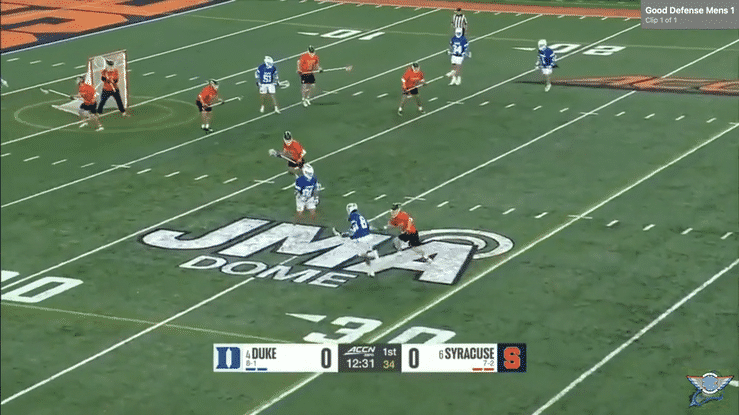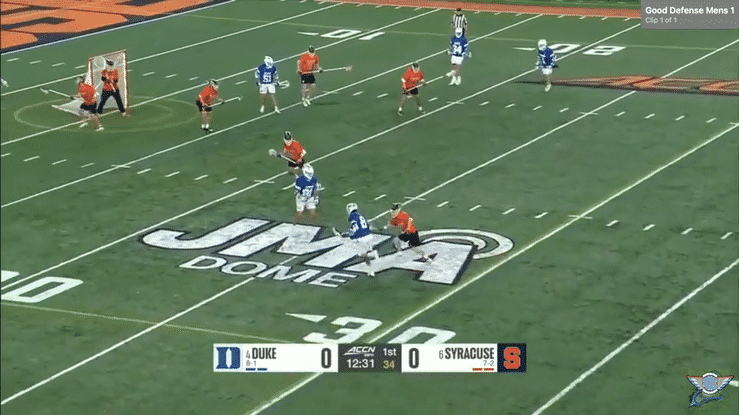Developing Elite Lacrosse Defenders: Tips & Drills from Jesse Bernhardt
Jesse Bernhardt, Maryland's Defensive Coordinator and Associate Head Coach, recently shared his insights on on-ball defense and drills in a detailed...

As defenders, our roles and responsibilities are in constant flux, dictated by the ball’s movement and offensive strategy. Executing these shifting demands at full speed is the cornerstone of effective defense.
Our roles could include supporting the ball as the slider, filling in as the two-slide, or splitting players as a backside splitter. Off-ball players often manage multiple responsibilities in these roles—for example, as a slider, you could be responsible for covering your man, connecting to the backside and being ready to support the ball.
The specific expectations for each role are shaped by your team’s defensive philosophy and system, providing the framework for how responsibilities are assigned and executed.
Additionally, roles can change dynamically as the play evolves. A defender who is hot to a dodge down the alley might shift to a fill or splitter role if the dodge redirects to the middle.
This post focuses on the specific roles and responsibilities of guarding a player at X when the ball moves down the side toward X. For clarity, X refers to the area behind the goal, below goal-line extended.
A few key points to keep in mind:
A general piece of advice off the ball is to flow with the direction of the ball. So as the ball moves down the side, a defense should generally be flowing in that direction. That means as an X defender, you will typically be working out towards your man at X. That being said, there are some subtleties to consider. I dive into these below.
In this approach, the X defender has no responsibility (or very little responsibility) to support the ball unless the play has broken. Instead, another crease defender assumes the slide responsibility. Your focus as the X defender is extending out to your matchup, playing through the passing lane to disrupt easy ball movement to and through X. This is one of the most common ways we see it played at the collegiate level.
Pros:
Cons:
Key Tip: Even in this scenario, be prepared to support and collapse on broken plays or secondary dodges. Players must be players. Your goal in this scenario often isn't to shut X, but to extend to it. You want to arrive with the ball and force the X attackmen to roll away from pressure when they catch the ball.
Film Examples: Here is a longer breakdown of Notre Dame defending low wing dodges. You'll notice how they work their X defender out as the ball moves down the side. Again, it's not a hard shut; but rather, just forces the X player to work deep to catch the ball.
Take a look at Riley Figueiras (#11) of Syracuse below executing this approach.

Hopkins often uses this tactic to slide and capture dodgers down the low wing as their dodge continues. Once again, it's not often a hard shut, but just being back there affects the play.

Here, the X defender prioritizes their matchup but shows support to the ball when possible. I consider this the "show when you can" strategy. If the X player drifts deep and isn’t an immediate threat, you can plug toward the ball. Communication with the crease defender is critical—let them know whether you can show with clear calls like “I can show” or “no show.” This is another very common strategy we see in lacrosse today.
Pros:
Cons:
Key Tip: Bluff early. Show hard before the dodger is ready to feed, then snap back to your player at X. Use a sideways stance with your stick in the passing lane to challenge the forward pass.
Film Examples: This is a rather subtle example, but many of these shows tend to be less obvious. In the GIF below, Ajax Zappitello's man is outside of the picture. Ajax reads that he is able to clog some spaces and get a jab to deter the dodge, and then get back to his man. Sometimes this is nothing more than just being in the play. Note how Ajax jabs and then moves back towards his man as the dodger steps away and puts his stick out in the lane.

In this scenario, the X defender is the primary support to the dodge. This is less common today as a primary strategy (ie, full on adjacent sliding from X). However, it can be an effective option for quick dodges off of ball movement, especially if the offense does not have a player on the crease allowing an easy crease slide from the defense. Your role includes sliding if necessary and ensuring a two-slide is ready to rotate to your player.
Pros:
Cons:
Key Tip: Focus on sliding through the passing lane to X to prevent an easy outlet pass.
Film Example: In this clip below, Maryland gets caught in the show and has to collapse. They execute a nice "slow play" to X here. This is not the perfect solution, but lacrosse is messy and players must make reads and decisions in the flow of the game. Transparently, I doubt this was MD's primary strategy; however, the players made the reads necessary.
Here's another example of myself in an old PLL game. Our primary defense was not to help off of X, but many times off of these quick redodges it is a read we need to make. We end up getting hung here, but that's better than giving up a goal on the "S" dodge.

This approach focuses on plugging to support the crease when a crease slide is imminent. It’s often a read the X defender must make when there’s no good two-slide option, but sometimes it's a gameplan as well. Your priority is protecting the area in front of the goal, even if it means leaving the X player more open.
Pros:
Cons:
Key Tip: Use stick to inside towards crease as your body creeps towards X. Be willing to "slow play" X and get hung if needed here. Remember, they can't score from X, but they can score from the crease.
Film Example: A subtle clip, but you'll notice how Kastner for Virginia (#39) on the crease plugs space above the goal even as the ball moves down the side. This affords an easy forward pass as he helps to clog up space on the crease instead. Notre Dame does such a good job of typically finding the back pipe on these dodges down the wing that I wonder if that is what spurred this strategy from UVA.

Many times a team or player cannot just implement one of these options throughout a game. You can pick one of these to be your initial strategy, but players must be players. If there is no crease slide, you may need to support from X on a broken play even if your plan is to extend to X. I look at these options above more as rules of thumb, or principles, rather than hard black and white rules; however, as coaches it is our job clarify these expectations with our players.
Defending a player at X while the ball moves down the side requires a balance of great stance, awareness, communication, and decision-making. Each of the four options—No Show, Moderate Show, Heavy Show, and Plug—has its own pros and cons. The key is to understand the defensive scheme, communicate with your teammates, and adapt to the offensive setup in front of you. Whichever option you prefer, the most important thing is having everyone connected and on the same page.
Check out our community and become a member to view drills, webinars, film breakdowns, courses and more. Use code BLOG15 for an exclusive discount to our membership community on Circle!
Jesse Bernhardt, Maryland's Defensive Coordinator and Associate Head Coach, recently shared his insights on on-ball defense and drills in a detailed...
Sliding in lacrosse involves sending an additional defender to defend the ball carrier and is a fundamental element of any man-to-man defense. While...
This is a noncomprehensive list of things I believe defenders in men's lacrosse should focus on to become better players. Some people might disagree...